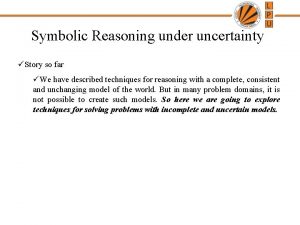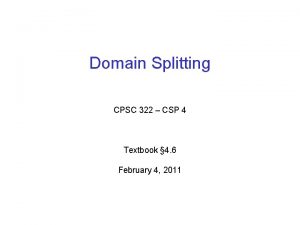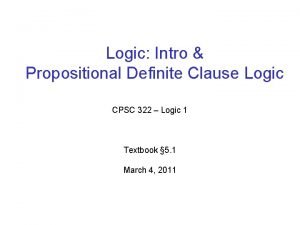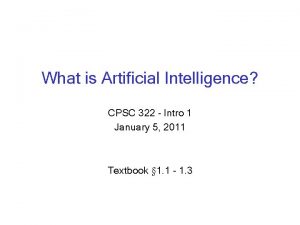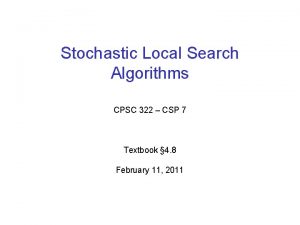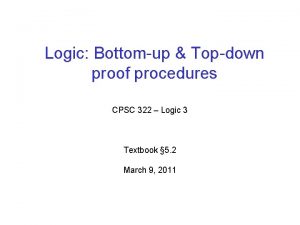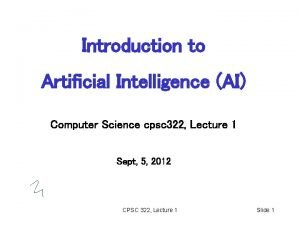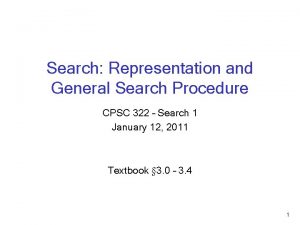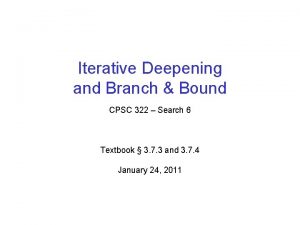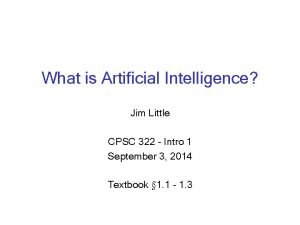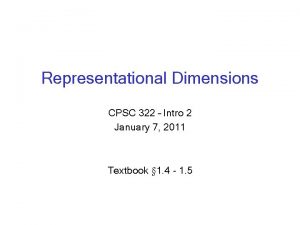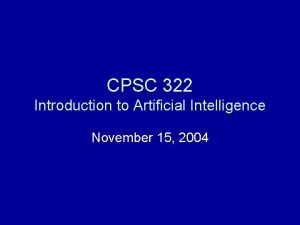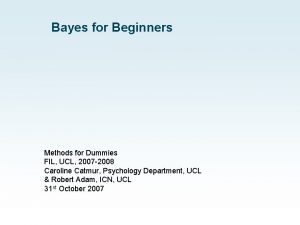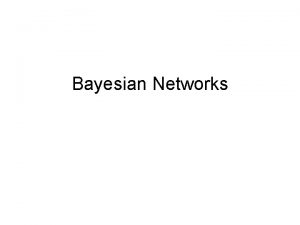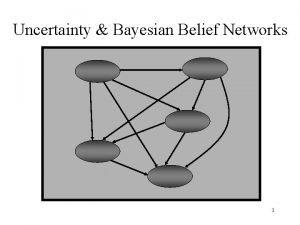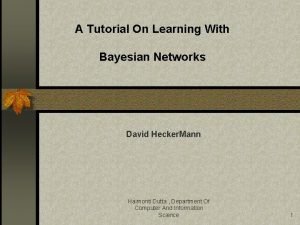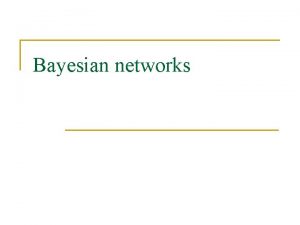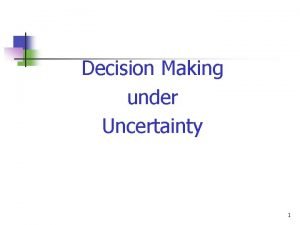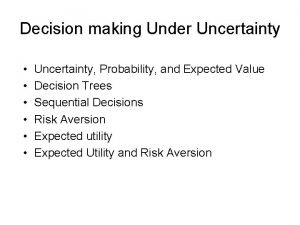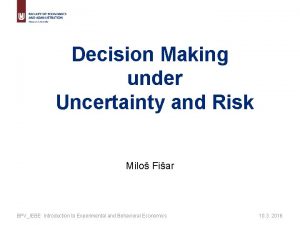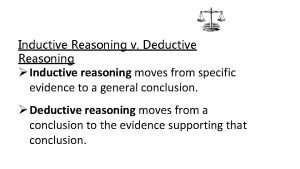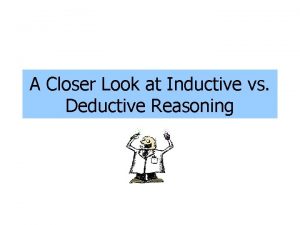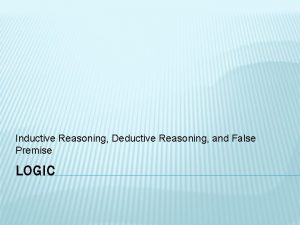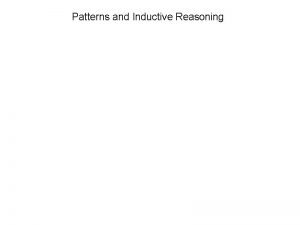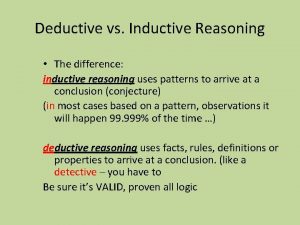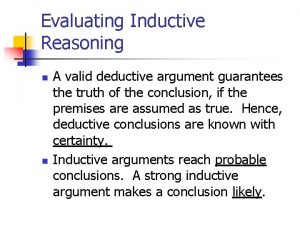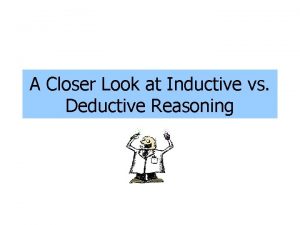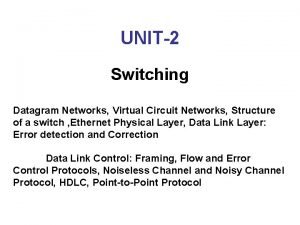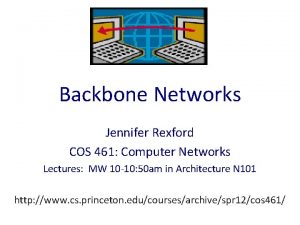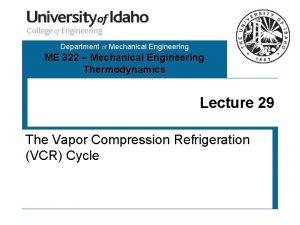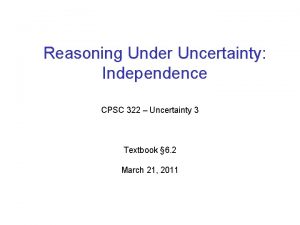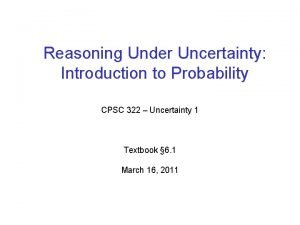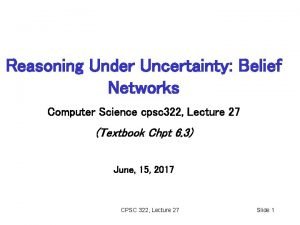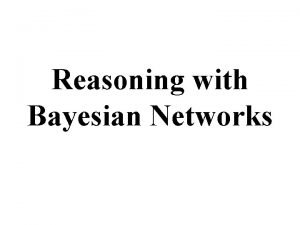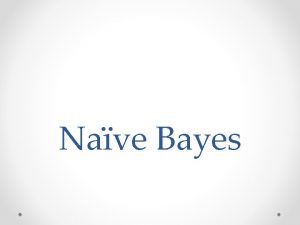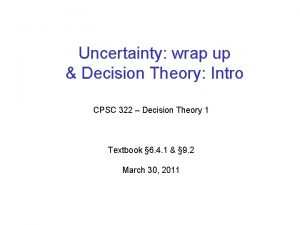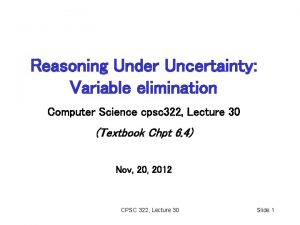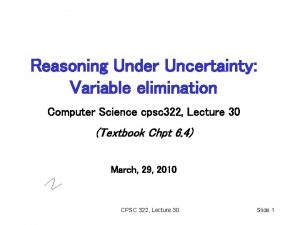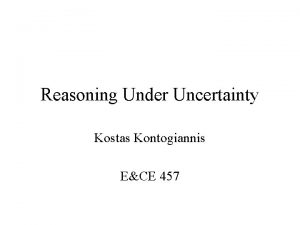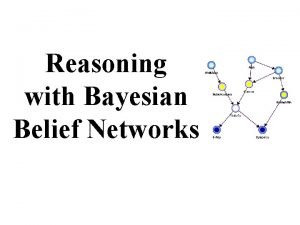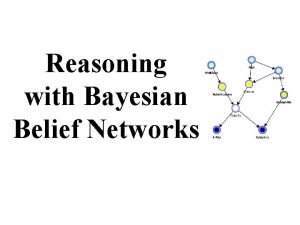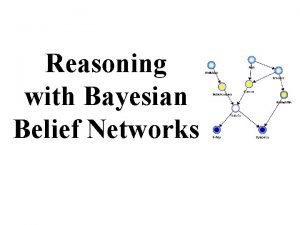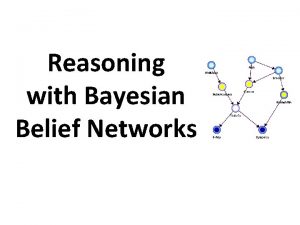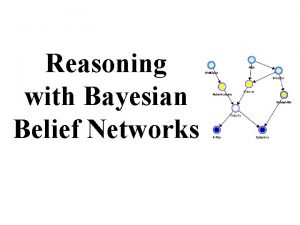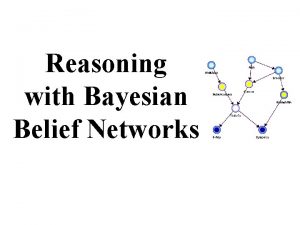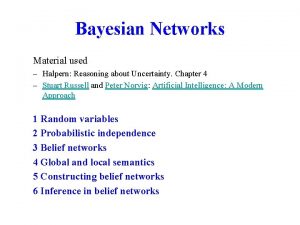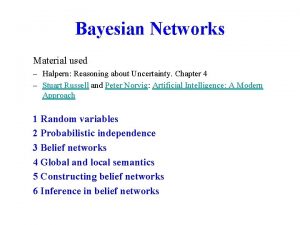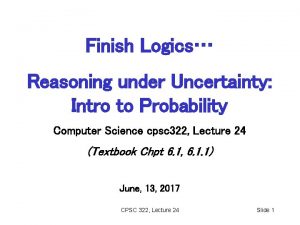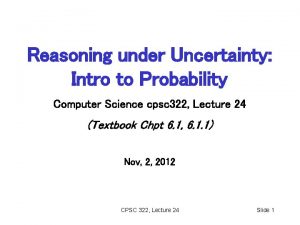Reasoning Under Uncertainty Bayesian networks intro CPSC 322

Reasoning Under Uncertainty: Bayesian networks intro CPSC 322 – Uncertainty 4 Textbook § 6. 3 – 6. 3. 1 March 23, 2011

Lecture Overview • Recap: marginal and conditional independence • Bayesian Networks Introduction • Hidden Markov Models – Rainbow Robot Example 2

Marginal Independence • Intuitively: if X ╨ Y, then – learning that Y=y does not change your belief in X – and this is true for all values y that Y could take • For example, weather is marginally independent from the result of a coin toss 3

Marginal Independence • 4

Conditional Independence • Intuitively: if X ╨ Y | Z, then – learning that Y=y does not change your belief in X when we already know Z=z – and this is true for all values y that Y could take and all values z that Z could take • For example, Exam. Grade ╨ Assignment. Grade | Understood. Material 5

Conditional Independence •

Lecture Overview • Recap: marginal and conditional independence • Bayesian Networks Introduction • Hidden Markov Models – Rainbow Robot Example 7

Bayesian Network Motivation • We want a representation and reasoning system that is based on conditional (and marginal) independence – Compact yet expressive representation – Efficient reasoning procedures • Bayesian Networks are such a representation – Named after Thomas Bayes (ca. 1702 – 1761) – Term coined in 1985 by Judea Pearl (1936 – ) – Their invention changed the focus on AI from logic to probability! Thomas Bayes Judea Pearl 8

Bayesian Networks: Intuition • A graphical representation for a joint probability distribution – Nodes are random variables – Directed edges between nodes reflect dependence • We already (informally) saw some examples: Smoking At Sensor Understood Material Assignment Grade Pos 0 Exam Grade Pos 1 Fire Alarm Pos 2 9

Bayesian Networks: Definition • 10

Bayesian Networks: Definition • Discrete Bayesian networks: – Domain of each variable is finite – Conditional probability distribution is a conditional probability table – We will assume this discrete case • But everything we say about independence (marginal & conditional) carries over to the continuous case 11

Example for BN construction: Fire Diagnosis • 12

Example for BN construction: Fire Diagnosis You want to diagnose whethere is a fire in a building • You receive a noisy report about whether everyone is leaving the building • If everyone is leaving, this may have been caused by a fire alarm • If there is a fire alarm, it may have been caused by a fire or by tampering • If there is a fire, there may be smoke 13

Example for BN construction: Fire Diagnosis First you choose the variables. In this case, all are Boolean: • Tampering is true when the alarm has been tampered with • Fire is true when there is a fire • Alarm is true when there is an alarm • Smoke is true when there is smoke • Leaving is true if there are lots of people leaving the building • Report is true if the sensor reports that lots of people are leaving the building • Let’s construct the Bayesian network for this (whiteboard) – First, you choose a total ordering of the variables, let’s say: Fire; Tampering; Alarm; Smoke; Leaving; Report. 14

Example for BN construction: Fire Diagnosis • Using the total ordering of variables: – Let’s say Fire; Tampering; Alarm; Smoke; Leaving; Report. • Now choose the parents for each variable by evaluating conditional independencies – Fire is the first variable in the ordering. It does not have parents. – Tampering independent of fire (learning that one is true would not change your beliefs about the probability of the other) – Alarm depends on both Fire and Tampering: it could be caused by either or both – Smoke is caused by Fire, and so is independent of Tampering and Alarm given whethere is a Fire – Leaving is caused by Alarm, and thus is independent of the other variables given Alarm – Report is caused by Leaving, and thus is independent of the other variables given Leaving 15

Example for BN construction: Fire Diagnosis • 16

Example for BN construction: Fire Diagnosis • All variables are Boolean • How many probabilities do we need to specify for this Bayesian network? – This time taking into account that probability tables have to sum to 1 6 12 20 26 -1 17

Example for BN construction: Fire Diagnosis • All variables are Boolean • How many probabilities do we need to specify for this network? – This time taking into account that probability tables have to sum to 1 • P(Tampering): 1 probability • P(Alarm|Tampering, Fire): 4 1 probability for each of the 4 instantiations of the parents • In total: 1+1+4+2+2+2 = 12 18

Example for BN construction: Fire Diagnosis P(Tampering=t) P(Tampering=f) 0. 02 0. 98 We don’t need to store P(Tampering=f) since probabilities sum to 1 19

Example for BN construction: Fire Diagnosis P(Tampering=t) P(Fire=t) 0. 02 0. 01 Tampering T Fire F P(Alarm=t|T, F) P(Alarm=f|T, F) t t 0. 5 t f 0. 85 0. 15 f t 0. 99 0. 01 f f 0. 0001 0. 9999 We don’t need to store P(Alarm=f|T, F) since probabilities sum to 1 Each row of this table is a conditional probability distribution Each column of this table is a conditional probability distribution 20

Example for BN construction: Fire Diagnosis P(Tampering=t) P(Fire=t) 0. 02 0. 01 Tampering T Fire F P(Alarm=t|T, F) t t 0. 5 t f 0. 85 f t 0. 99 f f 0. 0001 We don’t need to store P(Alarm=f|T, F) since probabilities sum to 1 Each row of this table is a conditional probability distribution 21

Example for BN construction: Fire Diagnosis P(Tampering=t) P(Fire=t) 0. 02 0. 01 Tampering T Fire F P(Alarm=t|T, F) Fire F P(Smoke=t |F) t t 0. 5 t 0. 9 t f 0. 85 f 0. 01 f t 0. 99 f f 0. 0001 Leaving P(Report=t|A) t 0. 75 f 0. 01 Alarm P(Leaving=t|A) t 0. 88 f 0. 001 P(Tampering=t, Fire=f, Alarm=t, Smoke=f, Leaving=t, Report=t) 22

Example for BN construction: Fire Diagnosis P(Tampering=t) P(Fire=t) 0. 02 0. 01 Tampering T Fire F P(Alarm=t|T, F) Fire F P(Smoke=t |F) t t 0. 5 t 0. 9 t f 0. 85 f 0. 01 f t 0. 99 f f 0. 0001 Leaving P(Report=t|A) t 0. 75 f 0. 01 Alarm P(Leaving=t|A) t 0. 88 f 0. 001 • 23

What if we use a different ordering? • Important for assignment 4, question 2: • Say, we use the following order: – Leaving; Tampering; Report; Smoke; Alarm; Fire. Tampering Leaving Alarm Report Smoke Fire • We end up with a completely different network structure! • Which of the two structures is better (think computationally)? The previous structure This structure 24

What if we use a different ordering? • Important for assignment 4, question 2: • Say, we use the following order: – Leaving; Tampering; Report; Smoke; Alarm; Fire. Tampering Leaving Alarm Report Smoke Fire • We end up with a completely different network structure! • Which of the two structures is better (think computationally)? – In the last network, we had to specify 12 probabilities – Here? 1 + 2 + 2 + 8 = 23 – The causal structure typically leads to the most compact network • Compactness typically enables more efficient reasoning 25

Are there wrong network structures? • Important for assignment 4, question 2 • Some variable orderings yield more compact, some less compact structures – Compact ones are better – But all representations resulting from this process are correct – One extreme: the fully connected network is always correct but rarely the best choice • How can a network structure be wrong? – If it misses directed edges that are required – E. g. an edge is missing below: Fire ╨ Alarm | {Tampering, Smoke} Tampering Leaving Alarm Report Smoke Fire 26

Lecture Overview • Recap: marginal and conditional independence • Bayesian Networks Introduction • Hidden Markov Models – Rainbow Robot Example 27

Markov Chains • X 0 X 1 X 2 … 28

Stationary Markov Chains X 0 X 1 X 2 … • A stationary Markov chain is when – All state transition probability tables are the same – I. e. , for all t > 0, t’ > 0: P(Xt|Xt-1) = P(Xt’|Xt’-1) • We only need to specify P(X 0) and P(Xt |Xt-1). – Simple model, easy to specify – Often the natural model – The network can extend indefinitely 29

Hidden Markov Models (HMMs) • A Hidden Markov Model (HMM) is a Markov chain plus a noisy observation about the state at each time step: X 0 X 1 X 2 O 1 O 2 … 30

Example HMM: Robot Tracking • Robot tracking as an HMM: Pos 0 Pos 1 Pos 2 Sens 1 Sens 2 … • Robot is moving at random: P(Post|Post-1) • Sensor observations of the current state P(Senst|Post) 31

Filtering in Hidden Markov Models (HMMs) X 0 X 1 X 2 O 1 O 2 … • Filtering problem in HMMs: at time step t, we would like to know P(Xt|O 1, …, Ot) • We will derive simple update equations: – Compute P(Xt|O 1, …, Ot) if we already know P(Xt-1|O 1, …, Ot-1) 32

HMM Filtering: first time step • By applying marginalization over X 0 “backwards”: X 0 X 1 O 1 Direct application of Bayes rule O 1 ╨ X 0 | X 1 and product rule Normalize to make the probability to sum to 1.

HMM Filtering: general time step t • By applying marginalization over Xt-1 “backwards”: Xt-1 Xt Ot Direct application of Bayes rule Ot ╨ {Xt-1, O 1, …, Ot-1} | Xt and Xt ╨ {O 1, …, Ot-1} | Xt-1 Normalize to make the probability to sum to 1.

• HMM Filtering Summary Observation probability We already know this from the previous step Transition probability 35

Learning Goals For Today’s Class • Build a Bayesian Network for a given domain • Compute the representational savings in terms of number of probabilities required • Assignment 4 available on Web. CT – Due Monday, April 4 • Can only use 2 late days • So we can give out solutions to study for the final exam – Final exam: Monday, April 11 • Less than 3 weeks from now – You should now be able to solve questions 1, 2, and 5 • Material for Question 3: Friday, and wrap-up on Monday • Material for Question 4: next week 36
- Slides: 36
